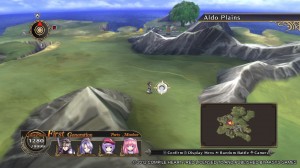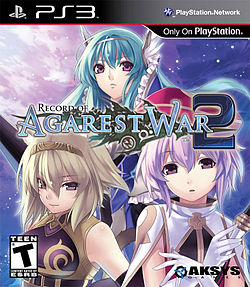 So Japanese RPG’s! They’re hated and loved in equal measure. Will Agarest 2 change anyone’s mind? Oh, Hell no!
So Japanese RPG’s! They’re hated and loved in equal measure. Will Agarest 2 change anyone’s mind? Oh, Hell no!
Lets start with the obvious. Do you have amnesia? Yes, yes you do. Or rather your moody, spiky haired protagonist does. Because he’s the God killer. But he doesn’t remember that. The God Killing.
An amnesiac hero is a pretty standard way to start a JRPG, and Agarest 2 is a pretty standard JRPG. Its unique feature is made clear in its subtitle: Generations of War. Agarest 2, like its predecessor, plays out across multiple generations. At certain points in the story you will choose who to mate with, and your resulting progeny will become the new main character. This is an interesting idea, and while the result of the union takes only the most cosmetic features of the parent, it’s still a clever way of crafting a grand story over a long time scale full of familial drama. The story is suitably epic in scope, and each new generation acts as a logical chapter end, preventing the story stagnating too much due to the ultimate (intrinsic) bane of the JRPG: grind.
 So while the games central theme of rebirth might be intriguing, everything else is very much standard JRPG fare. And not even modern JRPG fare; when you look at the gameplay, characters and story of Agarest 2 feels like it came out before Final Fantasy 7.
So while the games central theme of rebirth might be intriguing, everything else is very much standard JRPG fare. And not even modern JRPG fare; when you look at the gameplay, characters and story of Agarest 2 feels like it came out before Final Fantasy 7.
The structure of the game is immediately familiar. You have an overworld map that is low on detail. Looking very much like a PS2 title at these times, the overworld map is ugly and basic. You have a clear idea of where to go as “goal” is displayed on screen, and as you move from place to place you will face random encounters. At these times the game becomes a standard turn-based combat system. You know, where you stand opposite an enemy and wait for your turn before jumping forward, slashing them, then jumping back.
The combat is where the meat of the game is, and its here that the game gets both better and in some ways, much much worse. The turn based nature of the combat combines with some basic realtime elements. Pressing buttons can trigger attacks from different team members, and simply hammering on a button won’t work. Instead, timing and rhythm is important.
 In combat you have up to four controllable characters, but even these can be swapped out. Much of the challenge comes from finding the right skill and character (or combination of characters) that best exploit the weaknesses of the enemies you face. The bigger challenge though comes from the complexity of the combat. At first it seems manageable as each early fight comes with explanation from one of your companions about how the games combat systems work. While this seems reasonable at first, the game starts to layer system over system to the point where the complexity becomes completely unmanageable. You are given so much information that keeping it all in your head is simply impossible. I honestly started to feel like the game was some kind of parody at one point; the length of the explanations and the number of different meters, points and stats became hilarious. At first I read all these screens, but as I progressed I found myself simply hitting the X button over and over to make them go away. Trying to read them was pointless; it was simply too much to remember and beyond my intelligence to understand.
In combat you have up to four controllable characters, but even these can be swapped out. Much of the challenge comes from finding the right skill and character (or combination of characters) that best exploit the weaknesses of the enemies you face. The bigger challenge though comes from the complexity of the combat. At first it seems manageable as each early fight comes with explanation from one of your companions about how the games combat systems work. While this seems reasonable at first, the game starts to layer system over system to the point where the complexity becomes completely unmanageable. You are given so much information that keeping it all in your head is simply impossible. I honestly started to feel like the game was some kind of parody at one point; the length of the explanations and the number of different meters, points and stats became hilarious. At first I read all these screens, but as I progressed I found myself simply hitting the X button over and over to make them go away. Trying to read them was pointless; it was simply too much to remember and beyond my intelligence to understand.
This problem is exacerbated when you enter any of the games menu screens. You are immediately assaulted with information. Explained by one of the games characters (the cloying Aina), these reams of text can take minutes to get through even if you just keep hammering on the skip button WITHOUT READING THEM! Idea Factory games are renown for there confusing gameplay mechanics, but this is beyond ridiculous. If you want to learn all the intricacies of combat in Agarest 2, make sure you have no plans do do anything else for the year. Here’s an example of the kind of thing you will face:
 Cross Change (C button) lets you change the effect and appearance of an Original Skill. L1 button triggers an attribute attack which is relatively weak, but only consumes 1 UP, while R1 button doesn’t have any attribute effects it is incredibly powerful, but will consume 2 UP. When attacking with skills, taking special actions will get you various bonuses like AP and SP, as well as Wait reductions. During an attack, you can earn an SP bonus by changing your target’s motion state. When you reach the absolute apogee of a particular motion while continuing to assault an enemy with certain motion attack moves, you can increase the amount of recovered AP.
Cross Change (C button) lets you change the effect and appearance of an Original Skill. L1 button triggers an attribute attack which is relatively weak, but only consumes 1 UP, while R1 button doesn’t have any attribute effects it is incredibly powerful, but will consume 2 UP. When attacking with skills, taking special actions will get you various bonuses like AP and SP, as well as Wait reductions. During an attack, you can earn an SP bonus by changing your target’s motion state. When you reach the absolute apogee of a particular motion while continuing to assault an enemy with certain motion attack moves, you can increase the amount of recovered AP.
You’re probably thinking that makes sense in the context of the game. It doesn’t. You understand that as well as I do, and I’ve played for hours and hours (feels more like years).
To explain as best as I can, you usually have four controllable characters in combat, and choosing different leaders will change their formation and the bonuses they receive. Combat proceeds with your characters and your opponents fighting in turns, but in certain circumstances you can attack with any of your four characters by pressing one of the face buttons. During the first third of the game combat is easy, but moving into the later generations it gets tougher and grinding is essential. You can trigger a random encounter at any time by pressing a trigger, and you will find yourself doing this later to build your characters up enough to face the tougher enemies. Worryingly, a number of micro-transactions also allow you to buff your character and cheat your way to victory. My press copy included a lot of these, you might not be so lucky. Without them, the grind is likely to be even worse.
 There are some nice parts to the game too though. The menus look great and are surprisingly easy to navigate. The soundtrack is also cheesily brilliant, and from the J-Pop intro to the operatic scores throughout, it’s lively and engaging. There’s also PS Move support for some of the mini games.
There are some nice parts to the game too though. The menus look great and are surprisingly easy to navigate. The soundtrack is also cheesily brilliant, and from the J-Pop intro to the operatic scores throughout, it’s lively and engaging. There’s also PS Move support for some of the mini games.
Technologically the game is plagued with performance issues. The frame rate absolutely plummets during action scenes and even the most basic 3D models cause the whole game engine to turn into a shuddering, stuttering mess. Most of the story is advanced by cut-out, semi-animated anime characters delivering terrible dialogue. It helps that its in Japanese with English subtitles; if a voice actor had to utter some of these lines they would die of embarrassment.
The anime stylings of the game will delight and dismay in equal measure. While some gamers actively seek out titles where you give cute anime girls oil baths (as can be evidenced by their continued sales), most gamers will recoil. It’s part of anime culture, but its troubling for me and certainly not something I am desperate to see more of in games.
 An equally questionable issue is what they choose to animate on the characters during dialogue scenes. For the men, only their eyes and mouth move. For the women, it’s eyes, mouth and breasts. For some reason, any woman who starts talking in the world of Agarest punctuates the start of a sentence with bouncing tits. I checked with my girlfriend if this happens in real life, and after laughing for quite some time she reassured me that when she starts a sentence, the laws of gravity ARE NOT temporarily suspended in a localised area just below her chin.
An equally questionable issue is what they choose to animate on the characters during dialogue scenes. For the men, only their eyes and mouth move. For the women, it’s eyes, mouth and breasts. For some reason, any woman who starts talking in the world of Agarest punctuates the start of a sentence with bouncing tits. I checked with my girlfriend if this happens in real life, and after laughing for quite some time she reassured me that when she starts a sentence, the laws of gravity ARE NOT temporarily suspended in a localised area just below her chin.
I started this review by stating that this was a game that only a JRPG lover could enjoy. You really have to LOVE your JRPG’s to get anything from Agarest 2. It has a great soundtrack, the story is suitably epic, and the idea of a story spread over multiple generations is something that could have been great. Even the combat system is interesting. Despite these highs, Agarest’s brutal complexity, anime clichés, hateful characters and technical problems will make it difficult for all but the most hardened Japan-ophile to stomach.
5 bouncing anime boobs, disrespectful of gravity out of 10
